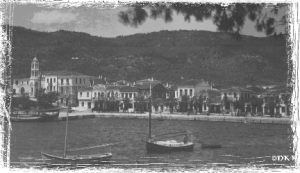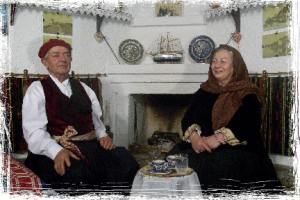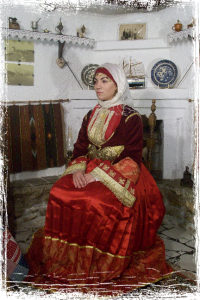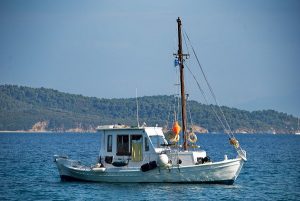 CULTURAL HISTORY PREHISTORIC PERIOD
CULTURAL HISTORY PREHISTORIC PERIOD
According to what is written in the Tour of Pausanias, the island in prehistoric times inhabited by the Pelasgians, pre-Greek people who came from Thrace. It is likely, however, before the installation of the Pelasgians in Skiathos, the island was inhabited by Kares probably also had arrived in Crete we know that they had occupied neighboring Peparithos (current Skopelos). This hypothesis is supported and that one of the sacred names of the god Dionysus, who was worshiped in other islands occupied by the Cretans was “Skianthios” adjective that resembles the name of the island. Later, they came and settled in Skiathos Chalcis. These were Ionians and seems to have arrived on the island in the Seventh or sixth century in one of the paths in order to establish colonies in Chalkidiki. the city built in the southeast of the port on the hill that dominates in the large bay and interior dual port. It was encircled by a wall of square marble stones, large and rough, and communicated with the mainland and the port with two gates. The city was inhabited throughout the Classical, Hellenistic and Byzantine periods until the time when the medieval town, castle in the north of the island. The island reappears on the historical scene during the Persian Wars in 480 BC when the Persian fleet descend from Greece, the Greeks were waiting at the temple of Artemis in Evia alerted with torches from the Skiathos. During the Lucerne, it seems that Skiathos has helped the Greeks and was one of the cities which did not emidisan “When the 478 / 7 eg established the First Athenian Alliance, known as the Delian League, Skiathos took the Athenians. During the Athenian alliance Skiathos like other cities of the alliance had autonomy and democratic government. He had that house, church name of the municipality and governor. As determined by “tax lists” preserved in Attic inscriptions, Skiathos included in the Thracian region, and pay thousands of drachmas per year, an amount too small, indicating that Skiathos was poor at the time. By the end of the Peloponnesian War in 404 BC after the defeat of Athens, Skiathos its conquest of Sparta and the government became an oligarchy. In 386 BC the Antalcidean Kingdom or peace, Skiathos was declared independent. The Spartans, however, violated the peace treaty and soon took over again, Skiathos, garrison and imposed heavy taxation. The 378 / 7 eg when Athens established the Second Athenian alliance in order to face the expansionist intentions of the Spartans, Skiathos tachtike back to her side. The Second Athenian hegemony, Skiathos remained at about 40 years and during this time the economic situation has improved so much that in the middle of the fourth example century minted bronze coins with the head of Hermes on one side and the word caduceus CKIATHI other. Later the island was used by the Athenians as a naval station and a base for their operations against Philip II of Macedonia. In 338 BC after the battle of Chaeronea and the victory of the Macedonians, Skiathos came to dominate.
HELLENISTIC – ROMAN PERIOD
The Macedonians settled in Skiathos oligarchic and the island remained undisturbed for many years. History emerges again from the time of Philip V (238-279p.Ch.) Skiathos those woes several years of battle with the Romans played in the surrounding areas. With the outbreak of the Second Makedonikoy war, for example 200/199 Philip gives orders to destroy the island of Skiathos and Skopelos not to fall into the hands of the enemy navy and used against him. The same year he arrived on the island, the Roman fleet and the fleet of Attalos I of Pergamon was an ally of Rome and plundered what was left of the ruined and deserted island. Despite the destruction of the city quickly recovered after the defeat of Philip in Canis heads in 197 BC restored democracy. In 146 BC all of Greece to the Romans conquered and Skiathos followed the same fate. In 42 BC, after the battle of Philippi, the winner Antony gave the island of Skiathos, along with some other islands at the Athenians as thanks to the help provided to him. Byzantium – Venetian Little information we have on Skiathos from the early Byzantine period. Administratively belonged to the province of Thessaly, which was part of Makedonikoy issue and the spread of Christianity in the island created a bishop belonging to the diocese of Larissa. In 758 AD on Constantine’s Kopronymou at the port of Skiathos was anchored by the Byzantine fleet, which went to help the attack Thessaloniki Bulgarians and Slavs. The G-AD Skiathos century suffered greatly from raids by the Saracens in the Aegean. When the Byzantine Empire by the Franks in 12O4 and the Aegean islands to the Venetians, Skiathos, Skopelos and islands of the Cyclades were the brothers Andrea and Jeremiah Gizis, Venetian merchants. Gizi The government gave the people with enough privileges and applied in the second Venetian domination, but abolished the Orthodox episkopi.Gia home and security of the city built in Skiathos a new castle in the Grand Harbour, the so-called Bourtzi. The brothers Gizi Skiathos dominated until 1259 and their successors for 17 more years until 1276, when the Byzantine fleet drove them out of the Northern Sporades. The island belonged to the Byzantine Empire until 1453. The Byzantine domination was rather typical because the pirates who plagued the Aegean those years did not leave Istanbul to enforce effectively the islands had been recaptured. So in the mid XIV century, the islanders, desperate by the successive invasions of both pirates and the Turks fled the coastal city and built a new, more secure, the Castle, north of the island on a cliff which was and natural fortress. When in 1453 fell Constantinople to the Turks, the islanders preferred the Venetian occupation because only Venice could protect them from the Turks. So they asked the Venetians to occupy the island on condition that they confirm the privileges they had given the island the Giza and will remain the headquarters of the Orthodox bishop, requests which were granted. So begins V’Enetokratia Skiathos which lasted until 1538. But the life of the residents did not improve, the raids continued, and the Venetians oppressed to such an extent that when in 1538 the castle was besieged by Barbarossa, who found some to escape the tyranny, do not hesitate to the deliver.
Byzantium – VENETIAN
Minimum information we Skiathos from the early Byzantine period . Administratively belonged to the province of Thessaly was part of the Macedonian issue and the spread of Christianity in the island , created bishop belonged to the diocese of Larissa. In 758 AD Kon on his / her mind Kopronymos , of the port was the Byzantine fleet anchored , who went to help the Thessaloniki by attacking Bulgarians and Slavs . The seventh AD century Skiathos suffered greatly from the raids of the Saracens in the Aegean . When the Byzantine Empire was overthrown by the Franks in 12O4 and the Aegean islands to the Venetians , Skiathos , Skopelos and islands of the Cyclades were brothers Andrew and Jeremiah Gkizi , Venetian merchants . The Gkizi government granted the inhabitants several privileges, and that applied in the second Venetian occupation , but abolished the Orthodox episkopi.Gia home and security in Skiathos town built a new castle in the great harbor called Mpourtzi . The brothers Gkizi Skiathos ruled until 1259, and their successors for 17 more years , until 1276, when the Byzantine fleet drove from Northern Sporades . The island belonged to the Byzantine Empire until 1453 . The Byzantine rule was rather formal because the pirates that plagued the Aegean at that time did not allow Istanbul to impose substantially the islands had reclaimed . So in the mid- fourteenth century the islanders , desperate following successive invasions of both pirates and the Turks abandoned their coastal town and built a new , more secure, the Castle , to the north of the island, on a cliff which was and natural fortress . When Constantinople fell in 1453 / town in the hands of the Turks , the islanders preferred the Venetian occupation because only Venice could protect them from the Turks . Therefore, they asked the Venetians to capture the island provided that validated the privileges given to the island Giza and will maintain the headquarters of the Orthodox bishop , requests which were accepted . So begins V’Enetokratia Skiathos which lasted until 1538 . But the lives of residents not ameliorated , pirate raids continued, and Venetian oppressed to such an extent that when in 1538 the castle was besieged by Barbarossa , found some order to rid of tyranny , have not hesitated to him deliver .
TURKISH (1538 – 1821)
The Turkish domination of Skiathos began in 1538 and formalized in 1540 with the signing of peace enetotourkikis. During this period the island was ruled by a Turkish commander, the voivode, which help the elders and notables, elected each year. year residents pay tax, the hike. There was also a kadi for judicial affairs, Aga for administrative, zampitis for taxation.
The islanders were forced to serve for a time the Turkish fleet, but later the term of compulsory The night turned into a financial contribution to the “melachika.
In the middle of XVII century, in 1660, the Venetian admiral Francesco Morosini occupied the castle and back for the third time the Venetian domination which did not last long because the Turks recaptured so and continued their dominance until the beginning of the Greek Revolution. Over the years the Turks living in Skiathos ligostefsan.
The office of voivodships (commander) ended up being bought by locals, and other Turkish authorities often were absent on the island and the services performed by the elders who thus gradually acquired more rights. But residents continued to suffer from piracy.
Despite all their trials, the islanders did not forgot to shipping. From the beginning of the eighteenth century began to build small ships that carried trade and transport to nearby places and later on larger ships, arrived in Egypt and the Black Sea.
The desire for freedom was lime for the islanders. So part of the victorious 1770 Battle of Cesme on the side of the Russian Admiral Orlov Alexiou and later provide men and ships to the legendary Greek thalassomacho Lambros Katsoni that operated at that time against the Turkish raids on the Turkish coast and attacks on Turkish ships.
An event of great importance to the island for Greece was to create the first Greek flag with a white cross on blue background in September 1807 at the Monastery of the Annunciation.

Giannis’ Mother
GREEK REVOLUTION 1821
The island, though it was far from the center of business and an easy prey to the Turkish fleet, soon tachtike favor of the Greek Revolution. At that time it had a sufficient number of ships equipped with trained crews from previous marine matches had taken place. So far Skiathan ships helped the race.
At the time, found refuge in Skiathos many refugees who were forced to flee their homes, when they failed revolutionary movements in these parts. In calculating the estimated 30,000 refugees from the villages of Pelion, Olympus, Euboea, the mainland who sought refuge in the Northern Sporades. The concentration of so many people in such a small part has resulted in creating housing problems, and food and were well-armed and between them-not long disturbed the order and anarchy prevailed. Thus, the island was afflicted for years by violence and looting, the Liapades, who remained in Skiathos even when most refugees returned to their homelands or settled in other places. In 1823 the Turks made an attempt to recapture, but decimated. In 1829, the signing of the London Protocol, which establishes the Greek state tributary to the Turks, the islanders fled the castle and moved back to port, where the ancient town of Skiathos.
POPULAR ARCHITECTURE
The skiathitiki folk architecture, not quite an island style. is a complex picture and insular village in Pelion, while combining and neoclassical elements.
The houses are usually small, built close to each other, two and stone, while the painting of external walls the only material used is lime. We meet two main types of houses: rustic and mansions. The old narrow streets of the island is made of stone slabs. In the middle of the road blocks are placed vertically into the earth in the shape of herringbone order to facilitate the removal of rainwater. In places where the streets are very narrow and the corners, the corners of the house is cut (Mitre) to facilitate moving them. Small squares are formed in different parts of the city, where there could be a gathering crowd, such as around and next to churches, fountains, etc.
 TRADITIONAL COSTUMES
TRADITIONAL COSTUMES
The characteristics of the male costume is the breeches and long fez with a long tassel, and resembled the attire of Hydra.
The traditional women’s costume consists of shirt, which is the most important and necessary part of women’s costume. It is long, reaching below the knees and the feature is the wide sleeves.
From worn over the shirt, which is crossed in front and fastened with two small buttons sewn into the neck of the jersey. They are usually wool or cotton and are white. black shirts worn by the elderly and those were mourning.
The socks are knitted from cotton or wool yarn and reached to the knee. And said the sock. Their color was white, but, as for the shirt, the very elderly or those women were mourning, wore black tsourapia.
FOLK DANCES AND SONGS
Most popular songs of Skiathos, is narrative. The principle of these songs, goes back to the Middle Ages. The most striking song is Skiathan Kamara.
The song is sung during the eponymous dance Skiathan In past seasons, he was the dearest dance for women, which danced dressed in the most formal dress, and with overflowing with after the Second Resurrection and the celebration of St. George.
The dance was performed on the roof of the castle, and later, when the residents moved the town of Skiathos, dance floors in the arch and later in the Holy Trinity.
SHIPPING
The involvement of the Seas Skiathio has a long history that starts in the mists of time evolves and undisturbed until today.
In the early 18th century, the islanders, having got rid of the Turkish restrictions, began to build their own boats in the bay of millet and to trade and transport to nearby places.
From 1774 onwards began to travel to Egypt and the Black Sea.
Already in the 18th century worked good with worthy shipwrights shipyards, which had the facilities in St. George near the lake. In 1804, according to the statistics of Adamantios Korai, Skiathos has 12 ships with 144 sailors and 48 cannons.
Since the period of action the station and Nikotsara the skiathitikos fleet was well equipped and these boats were used throughout the Greek Revolution in many businesses.
ALYPIAKOS WINE
The “Alypiakos wine ‘says the greatest of the Greek novelist Alexander Skiathitis Papadiamantis the tale,” The black logs “were appropriate n’ relieves’ Tash lypas their sorrows and sufferings of this world.” Recently, the Holy Monastery of the Annunciation of the Theotokos (EVANGELISTRIA) decided to prepare again the history of wine in sufficient quantity to meet the needs of the monastery and the numerous pilgrims and friends of the monastery.
“EOTHINON” – celebrated WAKING THE ISLAND AND TORCH OF MARCH 25
Over the last three years along with the celebration of this national celebration revived traditions, such as “EOTHINON ‘and’ Torch ‘under the auspices of the Municipality of Skiathos. “EOTHINON” – WAKING celebrate the island’s celebration was a wake up call “EOTHINON, was on the day of the March 25 morning at 5 o’clock, and the students of the sixth grade of elementary school then. Chanted the same with the torch marches and hymns of the Church. In this festive event celebrated the liberation of the nation. Over the past three years, is the revival of this custom from the local group Odigismou Skiathos Greek House in cooperation with the Municipality of Skiathos.
Torchlight March 25
The torch is in the evening at 8 o’clock on the day of March 25. The custom stems from the torch during the Turkish occupation, they had combined the Resurrection of Christ with the resurrection of the nation, the liberation of the nation by the Turks. And as we have in the Resurrection of the Holy Light of the Resurrection, in the same light is the light of Liberty. After the release of performance, the Resurrection of the nation and have the light, as in the Resurrection of Christ. For this custom of the torch was previously responsible for the island’s elementary school under the auspices of the Municipality of Skiathos. Then we all gathered at a primary school (because there was not even high school), and the Municipality of Skiathos handing out torches and candles and started the torch, where it ranks behind the school and the students followed by adults. Together they sang two marches – “All glory over as ‘and -‘ Tis the glory shining blue light in the Country” -. For some years this was not the custom, until in the 90’s Women’s Association Skiathos revived in the last three years continues Skiathos Municipality in cooperation with the Cultural Center of the Church and the Greek Parliament Odigismou Skiathos.
 FESTIVALS
FESTIVALS
April 23 – The feast of St. George. During that are horse races at Lake
July 26 – The feast of Agia Paraskevi Platanias.
And interesting events in the maritime week in July.
August 14 – The procession of the epitaph in honor of the Virgin in the monastery of the Annunciation, custom, unique in Greece
November 21, the Virgin Mary, the feast of the Virgin Mary Kounistra, patron saint of the island.
Historical Museum
Annunciation Monastery of Skiathos.
Tel 24270 22012

